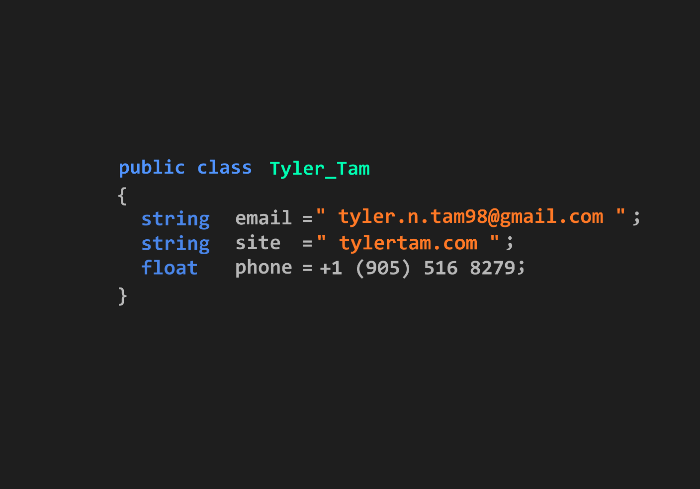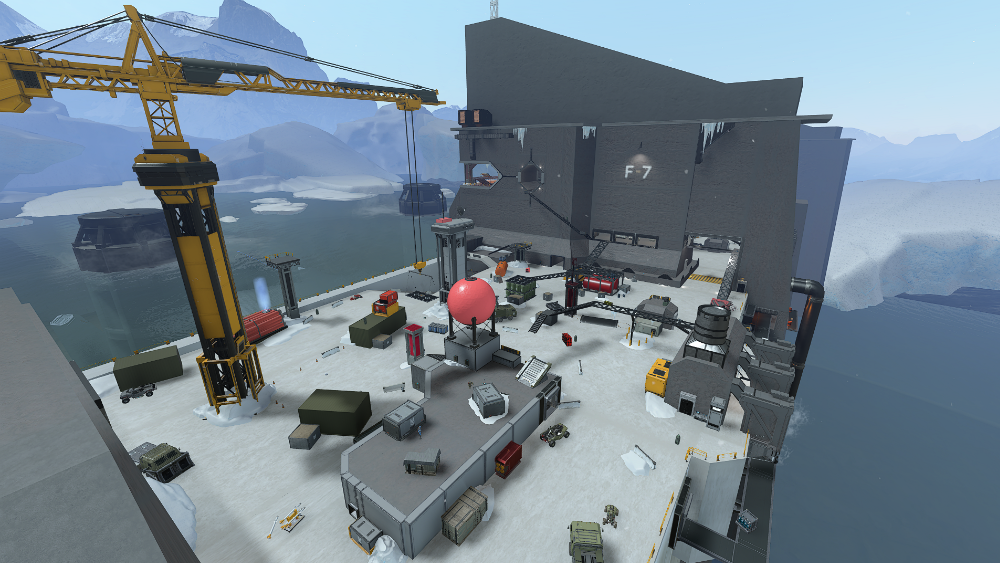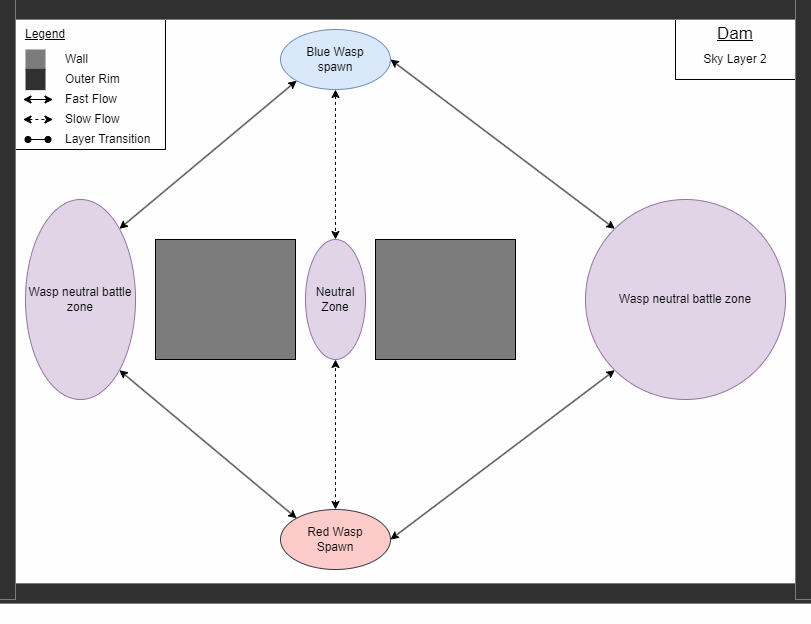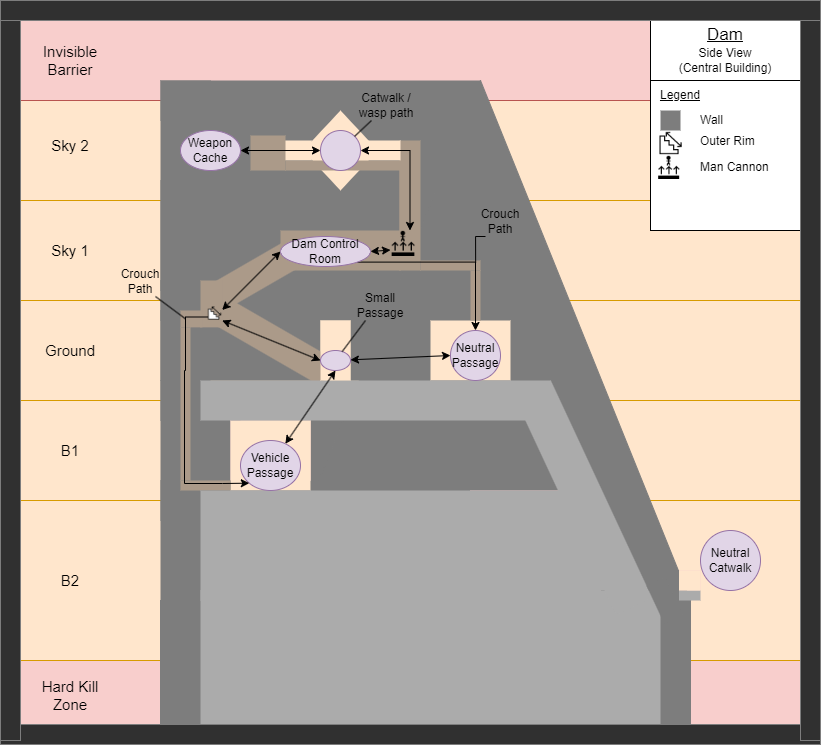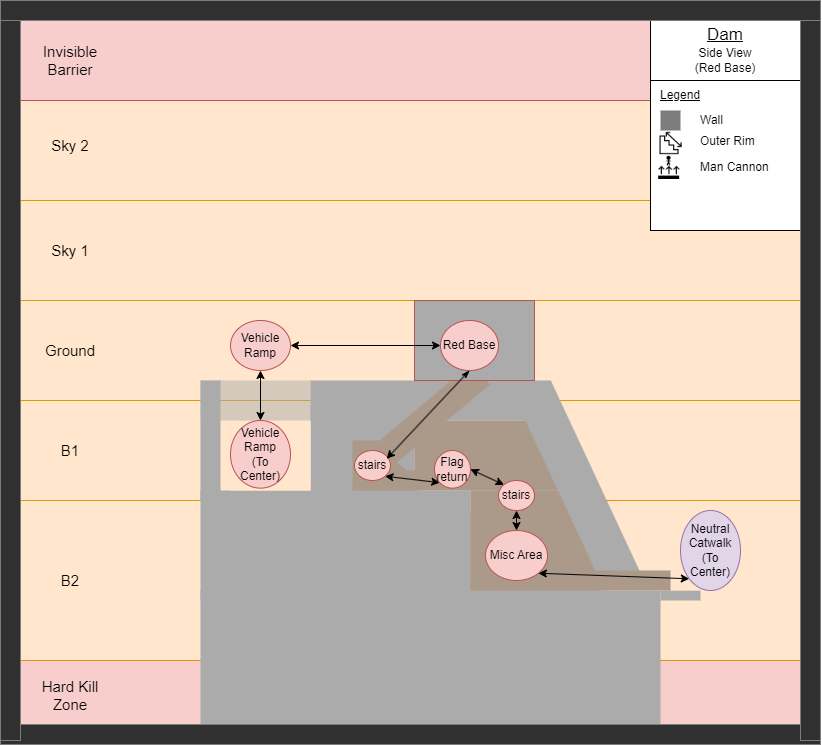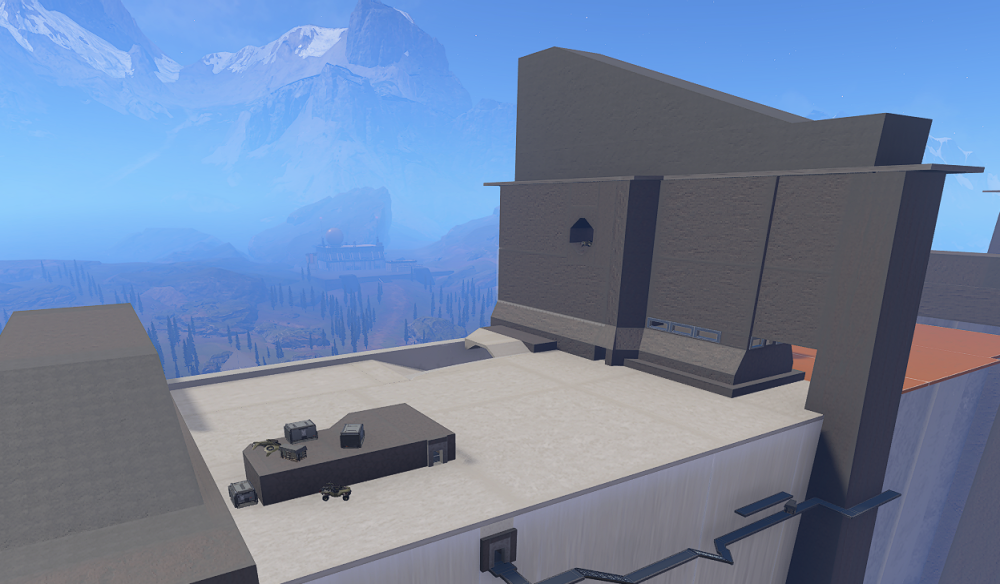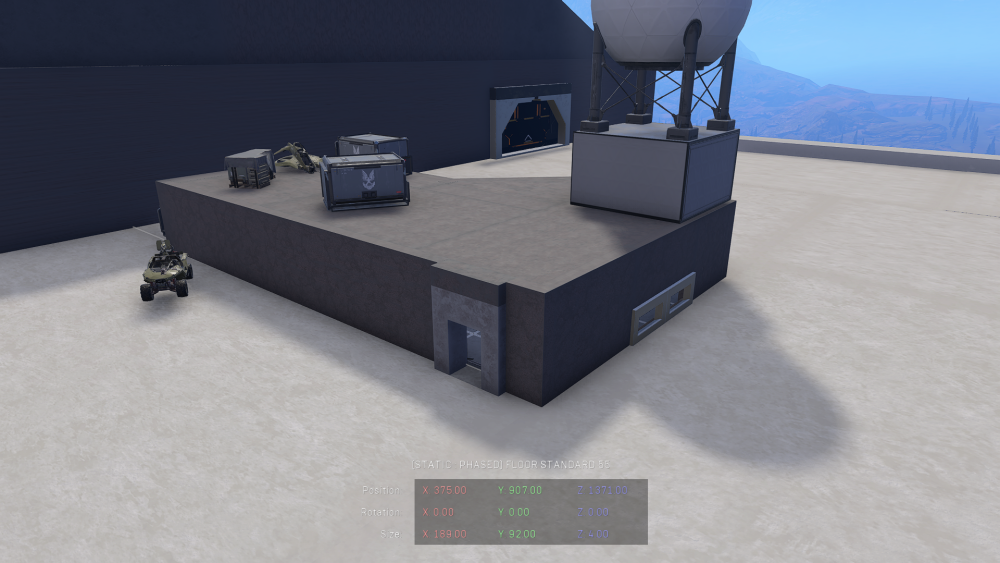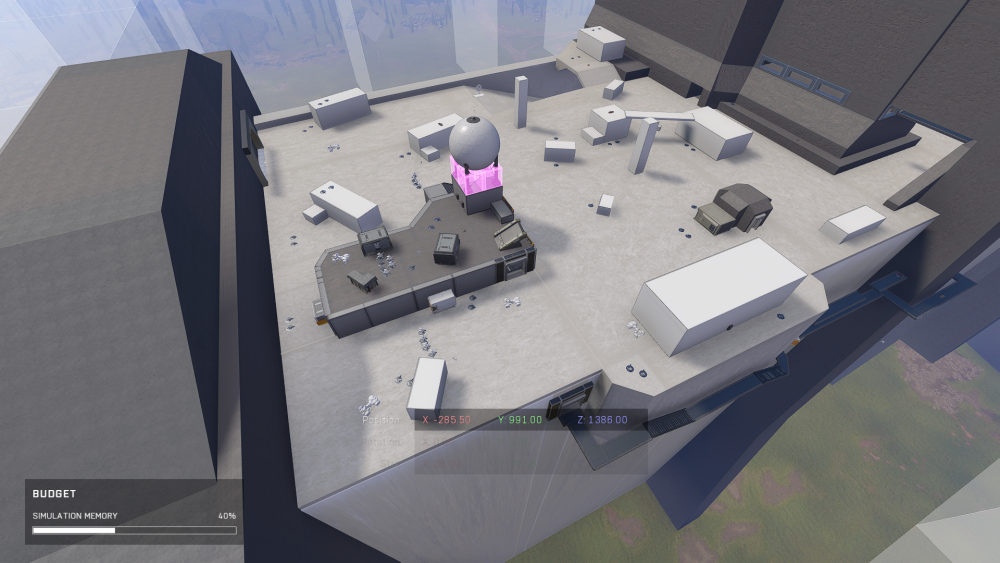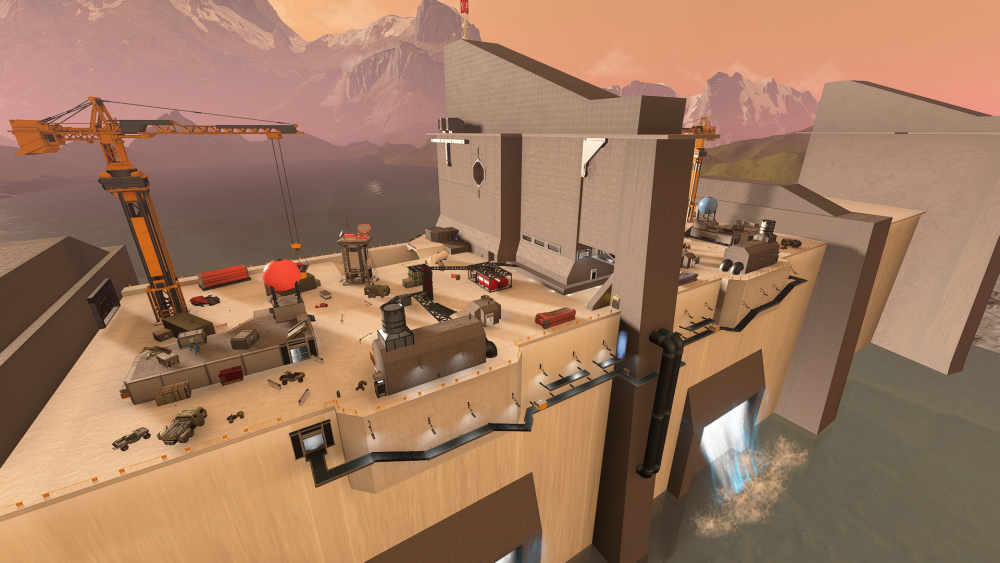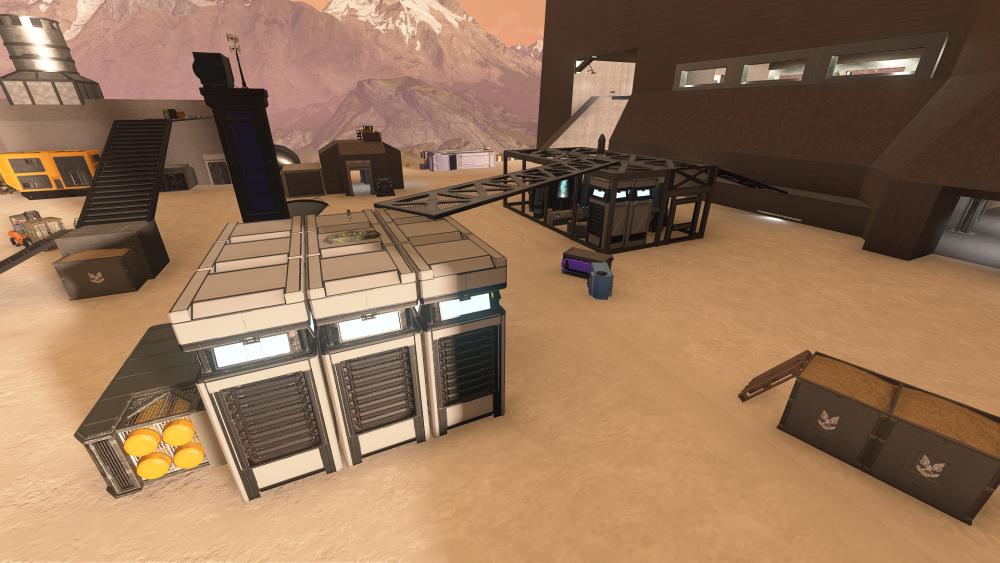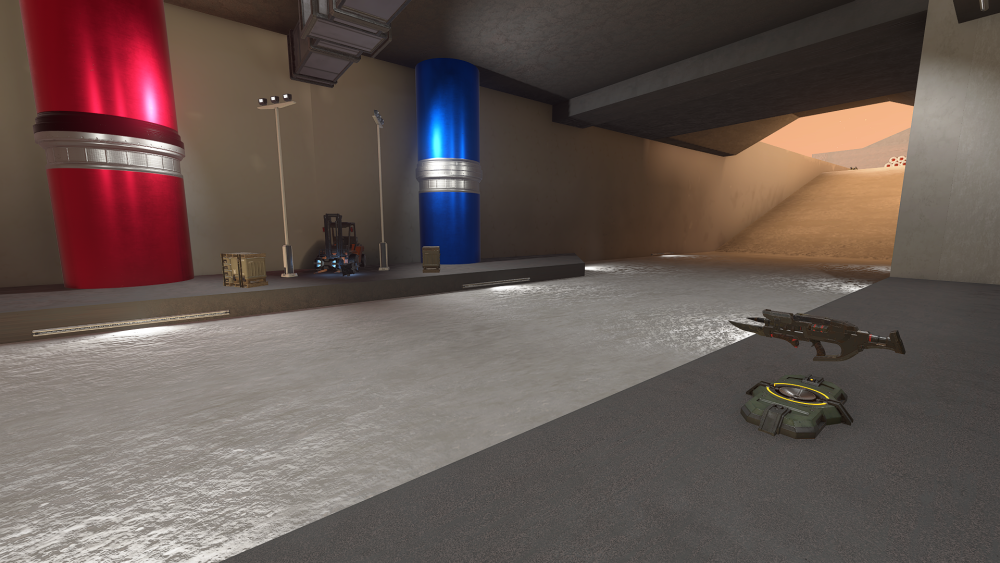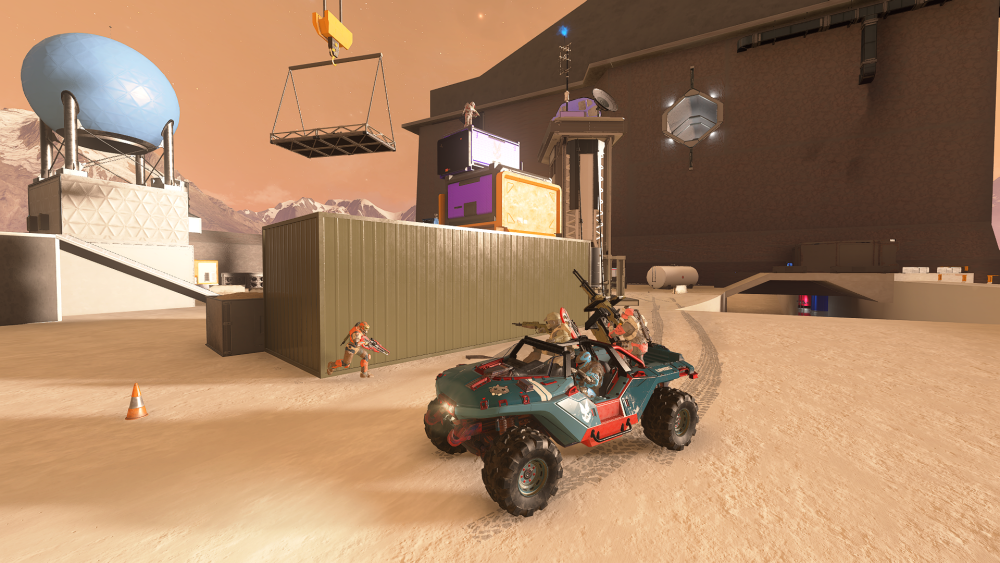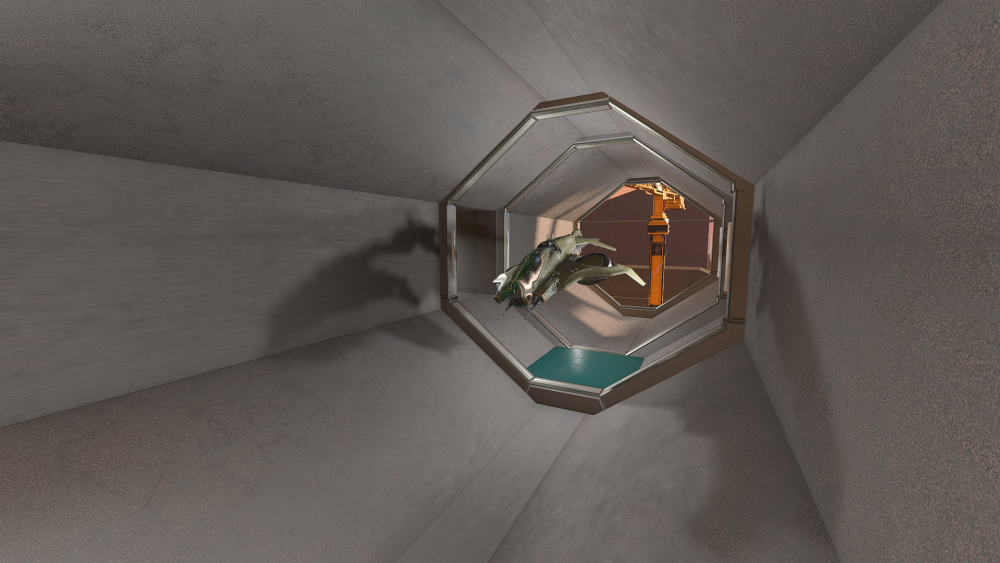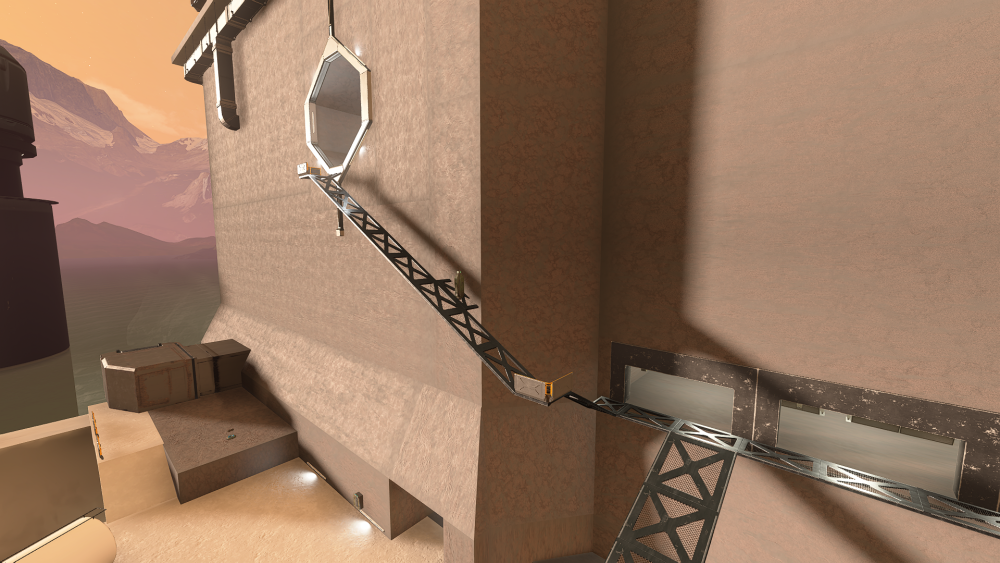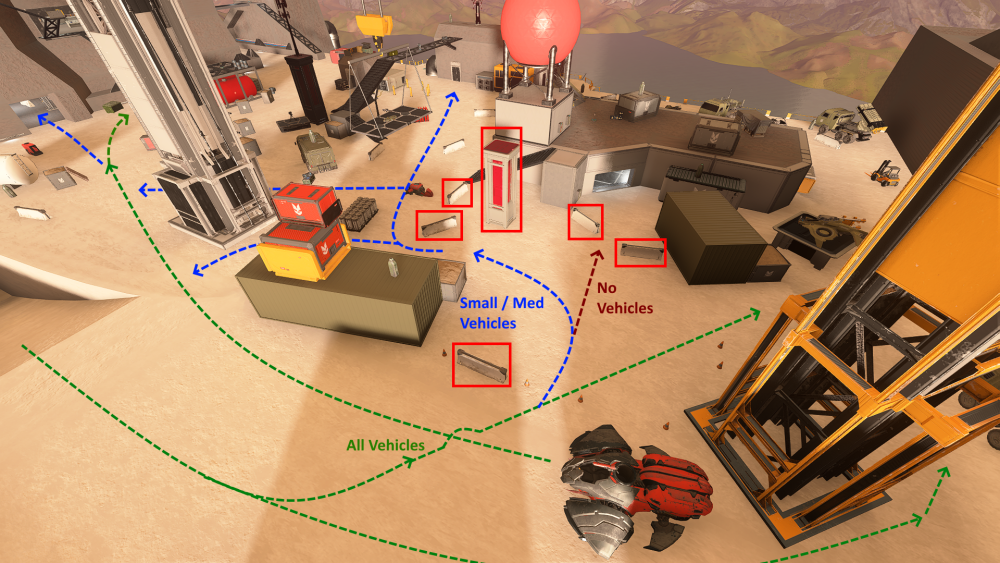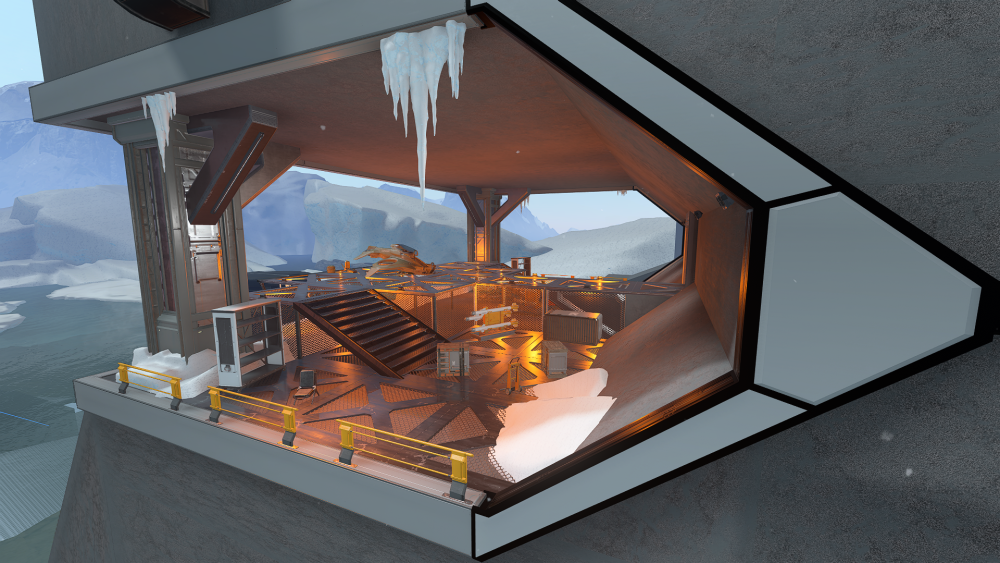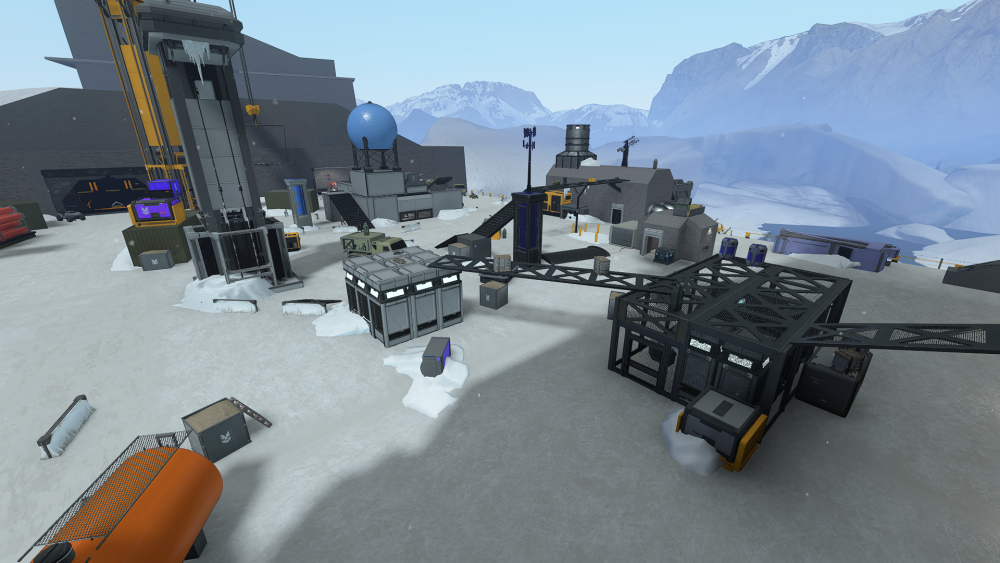Water Damage - Halo Infinite: Forge
Water Damage is a custom level I created in Halo Infinite's Forge level editor. The level is a 12v12 BTB oriented map, with foot soldier and vehicle gameplay designs.
Downloadable here on Halo Waypoint
Note: Level Design Document included at very end
Details
Time: Aug 2023
Team Size: 1
Tools: Halo Infinite: Forge
Role: Level Designer
Water Damage is a custom level I created in Halo Infinite's Forge level editor. The level is a 12v12 BTB oriented map, with foot soldier and vehicle gameplay designs.
Note: Level Design Document included at very end
Details
Time: Aug 2023
Team Size: 1
Tools: Halo Infinite: Forge
Role: Level Designer
Purpose & Goal
I started on this project shortly after leaving Little Guy Games (LGG) in a programming role. While I really enjoy programming, I wanted to explore more design related positions, as that is what I was always interested in. I experimented with some level designs at LGG on the many projects I was a part of, and I found I really enjoyed it. Additionally, I had some experience with designing a multiplayer FPS level during my game design program, and I really enjoyed creating my unreal tournmanet CTF level. As Halo was a big part of my childhood, I wanted to try creating a level in it's editor, and so I started on this project
My personal goal for this project was to create a portfolio piece, while also challenge myself to create a level design that incorporated vehicle gameplay and movement. I had previously only worked with 'on-foot' gameplay and platforming levels, so having another element added to the sandbox was an interesting challenge that I felt would really benefit my experience.
Design Process
I began pre-planning by re-reviewing my design document for my unreal tournament level, as I really liked the process I went through and documented. After reviewing it's process, I loosely planned out how I believed my process for this level would progress. This helped me get a better idea of what was necessary for the design.
In general, my process looked similar to the following list:
- Pre-planning / brainstorming
- Diagram layouts
- In-engine metric greybox
- Gameplay elements placements
- Initial art pass
- Playtest
- Fixes & additional art passes
- Second Playtest
- Final Touches
Typically, I would run a playtest before an initial art pass, just to test geometry, gameplay flow, and balancing, while the set dressing models are being created. But, since Forge already had the assets I would be using, going along with the art pass saved time. Additionally, placing some props really helped me get a better idea of how players would move about in the different spaces.
Pre-Planning
I began by thinking of environments that might be interesting for a 12v12. I had a few environments in mind; an underwater base, a forest, and an ice cavern. Ultimately, I decided on creating a level based around a large water dam. I felt that the large drop on one side of the dam would be an interesting play space for a Wasp (a flying vehicle), and the ground level of the dam would be a nice large space for both vehicle and foot soldier gameplay.
After deciding the environment, I brainstormed some interesting structures that would be great set pieces, while also presenting some great gameplay opportunities. I looked to existing dams, as well as existing structures in the Halo universe for some inspiration. In Halo CE, at the beginning of Assault on the Control Room a large forerunner structure is present, and I really liked the design and size of this structure, and I planned for the main structure of my level to look / behave similar to it.
One aspect that I really wanted to incorporate into this level was verticality in the gameplay. Aside from the Wasp, I wanted players to have the option of climbing up structures and gain some height, as I always enjoyed these types of maps in previous Halos.
After some more brainstorming, and ideation, I began to create some diagrams to map the connections of each space to eachother.
Diagrams
I started off with some bubble diagrams to get a better idea of how each space should connect to other spaces. This step really helped me identify how the different levels of vertical movement should interact with each other, and how players should be able to travel between the different spaces. As these diagrams were from a top-down view, I created multiple bubble diagrams, layered on top of each other, and it was easy to switch layers and see the space connections.
After creating the bubble diagrams, I wanted to plan out the interior of the central building in the dam. I moved over to a side-view of the building, which allowed me to plan for the elevation. During this step, I planned out the geometry for the building, including aspects like stair/ramp placements, gravity lift placements, and room placements. This diagram proved to be extremely helpful in having a better idea of what the interior should look like, which made the scultping, using Forge pieces, much much easier.
I also made a side-view diagram for the team bases, since I found the central building diagram really helped. Since the bases were going to be mirrored, I only created one for the red team.
In-Engine Metric Greybox
After creating those diagrams, I was going to plan out additional obstacles and props using another diagram, but I found that I could really determine how large these spaces & rooms should be, I didn't even know how large the map should be. So, I began work on sculpting a greyboxed level in-engine, as I was able to quickly determine how large a space should be, or if a space felt too large, etc. For the size of the map, I studied existing Halo Infinite maps as a reference, by timing how long it took to run from one base to another.
During this step, I constructed the central control building, as well as the red team base. I found that I had a really clear image of what the control building should look like, which really helped with the scultping, but I didn't have a clue on what the team base should be like. For the team base, I prototyped what some possible layouts could look like, testing the size, height, and time the player would spend navigating the different floors in the building. Eventually, I settled on a simple design that didn't stand out too much, but served it's purpose.
Overall, this step was really helpful, as I started to really plan out the scale of the map, and I also got to see my idea start coming into fruition.
Gameplay Elements
With a rough greybox created, I was able to start prototyping the placement of large obstacles & additional smaller buildings. During this step, I constantly switched back and forth between edit and player mode, trying to get sightlines, platforming and pathing feeling good.
After placing the props, I began on gameplay elements and their placements. This involved
- Spawing
- Vehicles & their placements
- Weapons & their placements
- Game mode elements (ctf, koth, etc.)
For what vehicles and weapons I should have in the map, I again referenced existing Halo Infinite maps, since those are already balanced for 12v12. That said, these inclusions were only as a starting point, and the included weapons generally changed throughout the many iterations.
For the gameplay elements, I placed them in areas that I felt they should be in as a player.
IE. the flags should be in a defendable position, but not a fortress, the hills/strongholds should be in more neutral positions
Setting up spawn points was a new challenge for me. While I had created maps in forge before, I had just loosely thrown spawn points around, without much thought. For this design, I wanted to create a better spawning setup that would be playable in an official playlist. To start, I put spawn points in areas that were behind cover, and generally out of enemy sightlines. After placing those, I started placing more in areas that players generally wouldn't travel to, like on the edge of the map, or in dead zones (by dead zone I mean areas that have nothing to do in them). Lastly, the backup spawn points (if all the other spawns are deemed 'dangerous' are in more neutral areas, as a last resort.
First Art Pass
I would normally conduct a playtest at this step, but began on the initial art pass first. This was because Halo already had art assets in their level editor, and also I had time before my testers were avaiable.
For much of the set dressing, it was a matter of finding some asset that fit the aesthetic of the map, while also being the same size of the greyboxed object it was going to replace. This proved to be easy for smaller props, but for larger greboxed objects, I needed to get creative. I had two sets of large objects, one was climbable by jumping, and one was taller than the jump height. I created some assets for these objects, and I also looked to the community for some inspiration as well. In the end, a combination of community assets, custom assets, and unchanged assets were used for props.
After placing some props, I wanted to get the lighting setup correctly, as I wanted to test it in the coming playtest (the next step). For the environment, I wanted a bright skylight that didn't obscure players, but also wanted a more cinematic / atmospheric lighting setup that wasnt set at night. I settled on my favourite time of day, sunset. From there, I placed smaller spot lights around the map, to light up the dark areas, while also adding some artistic appeal to bland looking areas.
First Playtest
I was finally able to playtest this map with other players, and obtain their feedback.
While playing, I quickly found that the current design was too restrictive in movement, epsecially in the control building. It felt that there were many spaces that only had one entrance or path to it, which made getting around the level difficult. Additionally, the vehicle pathing wasn't as clear as I initially believed, as the metrics for prop placements made it seem vehicles could easily maneuver in areas that they shouldn't. The same could be said for some foot traffic areas, as the metrics for some slopes and passages were weird and hard to judge. Lastly, many of the existing areas lacked a purpose for the player. There was no reason to go to them, or they were too open for foot traffic, leaving them as deadzones with little gameplay in them.
While there was a lot of feedback revolving around fixes, and changes, there were some aspects the testers liked. The wasp tunnel was the highlight of the map, and many players enjoyed that space, but they wanted more was to get to it on foot. The weapon & vehicle placements were deemed alright by the testers. Lastly, the overall theme was enjoyed, as well as the vertical-based design, but they wanted more opportunities for vertical movement compared to the current design.
From here, I began implementing some fixes and changes to the map, while also keeping in mind changes that I wanted to implement after playing in the map.
Iteration
I started by adressing the major point of feedback; the level's flow was very restrictive. To address this, I started to add more passages amd entry ways into the low circulation / singular passage areas around the map. This involved the changing of much of the control building's interior geometry, including lowering the wasp tunnel. I added an exterior walkway on the outside of the control building, in order to reach the wasp tunnel, which resulted in it's lowering, but it was a worthwhile change, as the exterior walkway not only opened up a new path, but also added another area for vertical-based gameplay, as the walkway was high up, and visible from many parts of the map. Additional changes included adding a foot path staircase on the lower vehicle ramp, re-factoring the hanging catwalk on the side of the dam, and adjusting the width of the small passage so that vehicles could travel through it.
The next task was rework the vehicle paths so that they were more clear to the player. My original idea was to keep the map open, and only add a few vehicle blockers in areas that I felt was necessary. This wasn't a great design however, as the openness led to indicisive driving, which often caused a crash or flip into unseen props / geometry. Realizing this, I started to plot out the vehicle paths, using many steel concreate barriers, and unmissible props. Because the warthog and mongoose drive fast, I needed the props to be very obviously placed, so they could be seen from afar, and allow the drive to plan their route in advance. After getting these paths setup, I realized that many of the objects I used also added cover to many open areas, which helepd me address another point of feedback more organically.
Environment Change
After the second playtest, I wanted to try to get my map into the official community playlist, and discovered that seasonal themed maps were being looked for, to put into the playlist. While I enjoyed the sunset theme I had going on in the map, I didn't feel it conveyed 'summer' or 'spring' that well, and decided to shift my map into a winter environment. As a result, I changed most of the map's environment. I did this by changing the outer environment to be set in a melting glacier ocean, and also placed winter environment pieces (piles of snow, icicles) around the map.
Since I had already playtested the playable map layout, it didn't change too much. I did, however, use piles of snow to fix some areas of concern I had discovered in the second playtest. IE. An area was difficult to climb onto, so I used snow to make it easier.
One major thing I found during the second playtest was that there were too many vehicles on the map. Thus, I removed a few mongoose, while also reducing the 2 wasps into a 1 wasp that was now placed in the center of the map, behind the wasp tunnel. Since this map is a very vertical oriented one, I wanted to make see how the wasp felt as a neutral power vehicle that players had to fight over, as it would be extremly useful in this map. Since the wasp tunnel wasn't exaclty designed for this, however, I had to sculpt out a new platform room the conencted to it.
Takeaways
Takeaways
Overall, I really enjoyed making this map, and I believe I was successful in achieving my goal of creating a moderate-large sized map, with balanced soldier, vehicle, and air vehicle gameplay. I learned a lot about map flow, and affordances while playtesting and iterating on the map, and I feel that my level design experience has improved.
While I am happy about the final design, I feel that the map could have been larger, in terms of its width. The width feels like a decent size for foot-soldier gameplay, but when players start to drive around, it feels a little small on the width. This could have been found out if I play tested some more during the grey boxing stage, and played with the vehicles a bit more, and I feel the design could’ve been better if I did so. But overall, the design matches what I wanted out of my map, and I am satisfied with the results for now.
Level Design Document
Download Level Design Doc
